-
Posts
3,878 -
Joined
-
Last visited
Content Type
Profiles
Forums
Events
Gallery
Posts posted by Cheeky Actress
-
-
Not necessarily.
Living here in WI all you have to do is wait 15 to 30 mins. and the weather will change. In the last three years, at least one day has had some rain in it. Just have to make the most of it….besides, it gives you an excuse to go to the ‘beer/food tent’ and hang with the locals…listen to great music, and relax until the rain stops.
-
-
cows
-
Update: Weather Conditions as of 10:50 AM today.
Jun 5 FridayMix of sun and clouds. Highs in the low 70s and lows in the mid 50s.
Jun 6 SaturdayShowers possible. Highs in the mid 50s and lows in the low 50s.
Jun 7 SundayShowers possible. Highs in the mid 60s and lows in the low 50s.
Hit or miss...we'll have to see when it gets closer.
-
RedJessi/withoutaname,
I've never worn a corset such as those shown on that site. What kind of 'support' does this type give you if you're ...'excuse the expression'...hangning out there? Just curious.
-
A very Happy Birthday to you Rats! Have a great time of it at Port Washington...!!!!
Chanting....
Tea-Pot Dance! Tea-Pot Dance! Tea-Pot Dance!
-
From the 1690s and into the early 18th century, the Fontange/Fontage was the choice of headdress for the middle-sort and court lady. We have examples of such items in paintings of famous gentry, engravings of ladies in every day affairs, and even a fashion doll (The Old Pretender) which is on display at the V&A Museum of Childhood in London (see previous blog page).
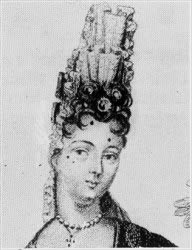
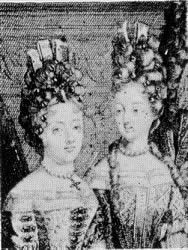

These exquisitely high, narrow towers of lace and linen were so high on its base of fluffed up natural hair and hair extensions, that the ladies' heads looked as if they were rather in the middle of the person than on top of the figure! By the end of the 17th century the Fontange took over the palissade form and style; wide and forward-tilted.
To construction the Fontange of the 1690, you will need the following materials:
• Unbleached white linen for the foundation – (light weight linen works the best - 2.8 oz.);
• Measuring tape;
• Millenary wire (16 gauge Rayon Wrapped Hat Wire Hat);
• Horse hair braid;
• Thin white ribbon for lacing cap;
• Scissor, pliers, and wire cutters;
• A steam iron;
• Cardboard or Kraft paper for a template/pattern;
• 100 percent cotton lace for trimming edges of the layers (no poly-plastic lace please);
• 1- ½ inch (or wider) 100% cotton lace for the long cornets which will flow down the nape of the neck/back (optional); and
• Starch, Sizing Spray or Fabric Stiffener /Draping Liquid.
Now that you have your materials, you need to decide on what kind of Fontange you wish to make. There are several different styles to choose from. There is the round style fontange and the one I like to call 'the Sky-Scraper' which is more of a narrow tower.
Here is an example of a towering High Court Fontage:


Today, I will be making a round, fan style Fontange.

There are two parts to this headdress: 1) the Fan-like tower that makes the Fontage; and 2) the bag or hair-bag, which you gather your hair into a bun.
The Fontage can be created from light-weight to medium-weight linen (28. to 3.5), lace (cotton or cotton blend), satin ribbon or a combination of linen and lace.
First, you will need to measure your head in order to get the correct fit for your Fontage and round bag. With a measuring tape you will need to measure; 1. From one ear – measuring over the top of your head - to the other ear; 2. From the center of the top of your head to the back nape of your neck; and 3. Measuring from the bottom of one ear lobe –crossing over the back of your skull (the nape) to the bottom of the other ear. These three (3) measurements will help with the size of the 'bag' and the size of the Fontage.
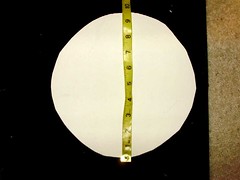
By using measurements from step 2 & 3, make a pattern of your round bag and increase it by 2-inches. Cut out the round bag. On the round bag, sew a casing strip - approx. 1-inch wide all round the bag. You can use a strip of linen or binding tape. The casing opening can be located at the top or the bottom of the bag. Either way will work when putting on your Fontage. Place this aside for now.
The Fontage itself is supported by wire and fabric, which helps to hold the fan-like hat erect from behind. To make the Fontage, make a pattern from measurement 1, and how high you want your Frontage. Looking at etchings from the time period (1690s), I have noticed that most of designs are several layers of linen incorporated into one. Therefore, I will join two (2) of them together. I have decided that the maximum height for this one will be 12 inches. Making a pattern from the width of your head (ear-to-ear) and the desired height, you will need to add 2 inches on each side for seam allowance.
Next, trim off the top edge of your Fontage with your lace of choice. Remember, cotton lace looks much better and take fabric stiffener (I will get to that shortly), much better than on the poly-plastic type-trim.
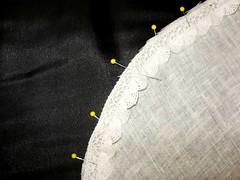
After you finish trimming the outer edge of your Fontage, take both 6-inch Fontanges and layer them together as one. A good guide would be to find thr center for both then stagger a measurement of approximately 3 inches (from the top of the lace to the bottom of the second layer) and pin it together for sewing.
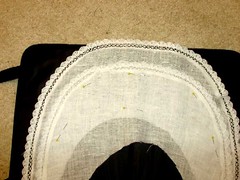
Once you sew them together, trim off the extra fabric from the center or 'headband' area.

Next….the pleating! You will need to make sure that you do a center box pleat first. Using an iron and a little spray starch, press your pleats into place. You will then sew your pleats into place at the bottom. You may wish to do this by hand or machine. Either way, you want to make sure that the bottom of your pleats are secure.
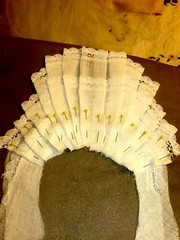
With the pleated fabric Fontage done, now you can incorporate the millenary wire into the Fontage. Cut six (6) to eight (8) lengths of millenary wire long enough to fit behind each of the folds of your Fontage minus 1-inch. Taking each piece of millenary wire, bend over both edges so the ends are rounded and tuck them into the fold of your Fontage pleat. Sew each wire into each fold until the whole Fontage is completed. Make sure to hide the wires in the pleated folds of the linen Fontage. This takes a bit of time. I make sure I tack down the pleat once the wire support is in place.
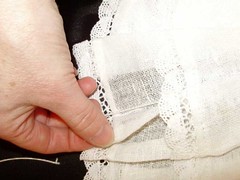

The 'headband' area can be covered with a two-inch wide piece of linen or lace to hide the mechanics of the pleating. To help make sure that your Fontange stays on your head, take a piece of 'horse-hair braid' and sew it to the headband - long enough for it to go ear-to-ear. This is a great trick for securing the Fontage into your hair/wig/fall/rat with bobbie-pins. Now attach your Fontage bag to the headband by sewing it to the linen strip, being careful not to catch the drawstring in the process.
This is the 'sticky' part. Apply 'fabric stiffener' spray to both sides of the Fontange. There are several types of this item on the market. Though you may purchase heavy starch for this task, I have found that spray starch it not as reliable as fabric stiffener.
This product you can find at any craft store in the glue area. This stuff is wonderful. Spray it on both sides of your Fontange until it is completely saturated and leave to dry over night. I like to hang mine on a door knob. It helps keep the pleated fan straight while it dries.
Now you have your Fontage any Middle Sort Woman or Court Lady would be proud to wear!
-
Yes, Lady Bower...that it tis!
There are other blogs related to this topic. Please make sure you check those out too!
** I just realized that you have to be a member of the site to view this blog. If that be the case, I will post the topic here.**
-

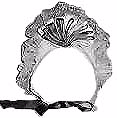
The Fontange or Fontage is a very unique headdress of the 17th Century. From 1690–1710, originating in France then making its’ way to England by the early 1690s.
A fontange was a lady's headdress named after Marie Angélique de Scorailles de Roussille, duchesse de Fontanges (1661–1681), mistress of Louis XIV of France and worn by women of the late 17th century and early 18th century. It is said that the Duchess tied her hair up with a ribbon after losing her cap while horseback riding. The king liked the look and it soon became fashionable.
Though this fad started around 1680, when relatively low, ribbon-trimmed caps appeared (e.g. the "fontange à la sultane", worn with a veil), it reached its height in the 1690s with very high towers of lace, and degraded both in height and popularity until about 1710.
It is well known though, that Louis XIV, for all his absolutistic dictatorship, did not succeed in abolishing this hairstyle, no matter what he did or threatened with. The King was not in favour of such excess, but while he himself had sparked the fashion, it grew up beyond his power to command.
Its popularity only waned in the 2nd decade of the 18th century, when all the lines and looks of fashioned changed towards the Rococo anyway.
The terminology is a tad bit confusing where the Fontange is concerned, as some authors/writers refer to it as the cap of that period, others for the hairstyle or combination of both. The use of commode/coiffure is also used.
As for the terminology of the commode and coiffure, many sources are not in agreement. Some state that the commode means a cap, while coiffure could denominate either the cap or the combination of the cap and its accompanying hairstyle. As the English "head of lace" usually referred to the cap.
The next two paragraphs describe the Fontange/Commode in detail. Note the height of each one.
In the appearance of the Fontange, or commode as it became known in England, was a striking note in women's ever-changing attire. Tiers of lace, rising to the height of twelve inches, were fastened one above the other on a wire frame covered with a thin silk such as "tiffany," and set well forward on the head. The hair was parted in the middle, forming small curls over the temples called "confidents," and then drawn into a knot on the crown of the head behind the commode, with long curls falling over one shoulder. High lace caps were also worn with falls of lace each side of the face.
It was a framework of cap wire about half a yard in height, divided into tiers and positively covered with bands of muslin, ribbons, flowers, chenille, and upstanding aigrettes. To each tier of the structure names were given such as the Duke, the duchess, the Capuchin, the Solitary One, the Asparagus, the Cabbage, the Cat, the Organ Pipe, the First or Second Sky and the Mouse. The last a little bow of "nonpareil" fixed in the fringe of crisply waving hair that was arranged below the curled "fontange."
Again, other source use the term commode for the high hairstyle which appeared at the same time as the Fontange, yet, the term as also been used to a bum roll (rump). It is quite possible that period terminology/slang for this item indecisive.
Depending on the decade you are researching, the commode, if we agree that it refers to a cap, could take on just about any shape or size. At the beginning of the 1690 the lace-surmounted cap, which we now refer to as a Fontange.
-


 $50 for a Shuttle?! Well, I guess I won't be doing anything extra next weekend.
$50 for a Shuttle?! Well, I guess I won't be doing anything extra next weekend.
-
I will be happy to contribute to dinner...perhaps there is a store 'not too far' from the camp site? Seeing that I am without a car, I am unable to make this run by myself. Perhaps we can discuss more on this come Friday?
-
Addict
-
..... after talking with my wife.....having not mentioned the dress when I first mentioned PiP she loved the idea of having a dress like Elizabeth (POTC1) and has told me that her aunt (been sewing her life) would once again take up a needle and help sew.
Vintagesailor,
The Elizabeth Swan gown (POTC1) you are referring to is a very lovely dress, but the date of it is off about 50 to 70 years from the Golden Age of Pyracy.
The green and pink "Dutch Mantua" that I posted on the afore mentioned page dates back to the late 1690s. The cut is completely different. There are several books mentioned here...such as the Janet Arnold book listed above - will give you a perfect period correct mantua you are looking for.
There are many here who can help you with questions and direction you on the right path if you want that 'perfect' attire for your lovely wife.
Just ask away, sir.
-
'bbcddutchman' date='May 28 2009, 12:01 PM
There is also a rumor the Festival would not be happening next year....Oh, I'm not worried, Dutch. You mentioned the fact that it is a rumor...and we'll just have to see what occurs after the dust clears for this event.
How's the weather looking for Friday thru Sunday anyway?
-
Oh Miss Lilly your new avatar looks like a screen shot from a cooking show on the GAoP food network. Sorta a Rachel Ray with a cutlass!
Well, I'll take that as a complitment, SutlerJonSeeing that we're both from Upstate NY, I would love to share my famous recipe for pig trotters. It's a quick meal from camp fire to table in 30 mins!
-
Wow! Possibly no Blackbeards Fest for 2010?! We'll just have to see what the powers that be have to say then. Keep us in the loop.
-
 ...gee, the way they had the 'drynk police' out last year...I find that may not be a problem, Silkie. But I do like the 'rope off' idea.
...gee, the way they had the 'drynk police' out last year...I find that may not be a problem, Silkie. But I do like the 'rope off' idea.
-
....Whats on the plate you might ask? The capture of William Howard, which has not been done in three years. The ball Friday night, now at the Crown Plaza Hotel. (pirate hunters, this means no late night drunks wandering through your camp!)
(Lilly Frowning)...Does that also mean no late night singing? We've got to have at least one great Forecastle Shanty that evening!
-
LOL! Rumba...though the fabric is off about 200 years...I have found a better pattern to use...but still looking for the right colour scheme.
I have put the Dutch Mantua on hold for now until I can find the right stuff...though, I did purchase something for a Middle-Sort Mantua instead. The colours will be cream and gold.
-
On Memorial Day afternoon...I went to the 'evil place' - JoAnn Fabrics. Not only did I go to the Brand New Mega Store they just finished in Appleton, WI ...but they were having a 50 percent sale ...AND an additional 10 percent off your total sale...plus if you had a military ID...it was another 10!
I broke out in a cold sweat and all I could hear was Christopher Lowell shouting my name from Home Decor...and look what I found in his row of fashion home decor fabrics! (Chick Scream)! Just $9.99! (Granted it is NOT Silk, but a blend of poly and something else)...
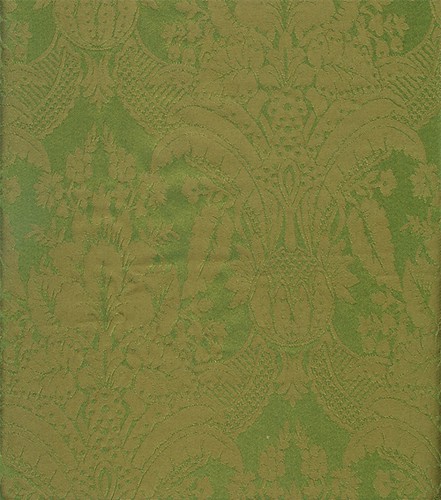
and this!

and Lastly...
My choice...(only if they had enough of it!)
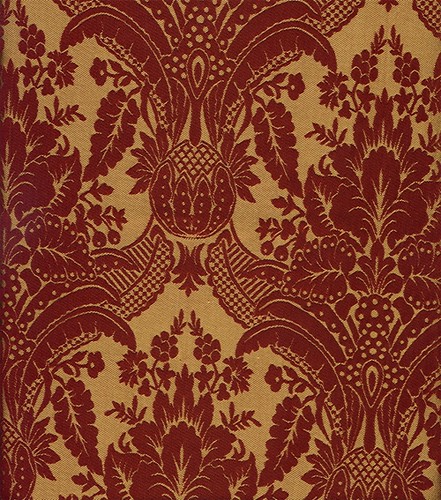
Look like a good start on the Dutch Mantua!
-
Rumbling
-
and this arrived from the naval archytechy today. ain't she purdy!

Wow~! Look at the lines on her! She'll be the envy of all who sees her.
-
$25 bucks?! That's it?!...I'm there....
 ...and you are quite welcome Lady Brower!
...and you are quite welcome Lady Brower! -
Oi Lily, thank you for the heads up! Now...off to find me bowl and spoon...



PYRATES WAY RADIO IS BACK
in Pyrate Pop
Posted
I got my link and I'm ready to list with the best of them!